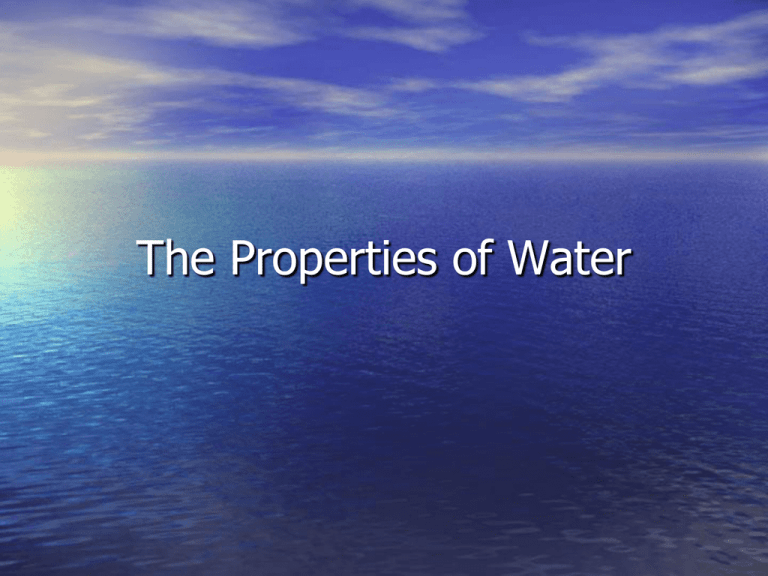The Properties of Water
advertisement

The Properties of Water The Mickey Mouse Molecule! Hydrogen Hydrogen Oxygen Structure of a Water Molecule • Water is polar. • A polar molecule is a molecule that has an electrical charge. • Water is made of: • 2 Hydrogen Atoms and 1 Oxygen atom. • The chemical formula for water is: H2O • Hydrogen has a positive (+) charge and Oxygen has a negative (-) charge. 4 Key Properties of Water • Capillary Action • Surface Tension • Universal Solvent • Specific Heat Capillary Action • Capillary action is the combined force of • attraction among water molecules and with the molecules of surrounding materials. Examples of Capillary Action of Water: – – – – – Liquid rising inside a straw Paper towel absorbing water Wet jeans Plant roots absorbing water Sponge Surface Tension • Surface tension is the tightness across the surface of water that is caused by the polar molecules pulling on one another • Examples of the surface tension of water: – – – – – – – Raindrops forming beads on surface Water strider Paperclip Floating on Water Drops of Water on a Penny Skipping Rocks Meniscus Belly Flops Jesus Lizard Water Strider Universal Solvent • Solution: A mixture that forms when one substance dissolves another. • Solvent: substance that does the dissolving. • Solute: substance that gets dissolved. – – - Water is the universal solvent because it dissolves so many substances because of its high polarity. Water can dissolve substances such as salt and sugar but cannot dissolve oil. Polar Dissolves Polar. Specific Heat • • • Water requires a lot of heat (gain or loss) to change its temperature due to the strong attraction among water molecules. Specific heat is the amount of heat needed to increase the temperature of a substance by 10C Example of specific heat: - Water temperature vs. sand temperature at the beach during the day. Why does water have a high specific heat? – Water’s high specific heat is due to the strong attraction among water molecules. – The molecules are stuck together and it takes a lot of energy to break the strong bonds of the water molecules. Changing State • Water exists in 3 forms: – solid – liquid – gas solid liquid gas Molecule Movement Molecules move the slowest in a solid. Solid-molecules are close together Molecules move the fastest in a gas. Gas-molecules move freely; they are spread apart Phase Changes • Melting-water changes from a solid to a liquid – Example: Ice melts into water • Freezing-water changes from a liquid to a solid – Example: Water freezes into ice Melting Solid Liquid Freezing Phase Changes • Evaporation- process by which molecules at the surface of a liquid absorb enough energy to change to the gaseous state – Example: boiling water, hair air-drying, wet clothes drying on a clothesline outside, puddle drying up • Condensation-process by which a gas changes to a liquid – Example: water droplets on the outside of a glass fogging up a window Evaporation Liquid Condensation Gas Phase Changes Phase Change Diagram








